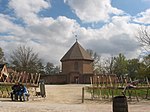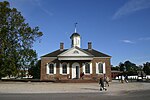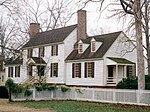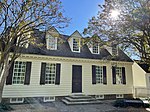Ludwell–Paradise House

The Ludwell–Paradise House, often also called the Paradise House, is a historic home along Duke of Gloucester Street and part of Colonial Williamsburg in Williamsburg, Virginia. The home was built in 1752–1753 for Philip Ludwell III. In December 1926, it became the first property John D. Rockefeller Jr. authorized W. A. R. Goodwin to purchase as part of the Colonial Williamsburg restoration campaign. After being restored, the Ludwell–Paradise House held the Abby Aldrich Rockefeller Folk Art Collection from 1935 to 1956. The building now serves as a rented private residence in the Williamsburg historic area. Philip Ludwell II purchased the lot where the Ludwell–Paradise House was constructed in September 1700. Possibly built on the site of a prior house that was constructed between 1680 and 1690, timbers in the surviving structure were dated as being felled in 1752 and brickwork indicates the entire building was completed simultaneously. After being used as a rental property, a tavern that once hosted George Washington, and a host for The Virginia Gazette newspaper, the house's ownership passed to William Lee. Though their legal claim to the house was unfounded, Philip Ludwell III's daughter Lucy Ludwell Paradise and her husband, John Paradise, were associated with the house, giving the building its name. When the house was one of several properties seized from Paradise and Lee by Patriots during the American Revolutionary War, the Paradises' friend Samuel Johnson privately quipped about "Paradise's loss". Lucy Ludwell Paradise lived in the home from 1805 until she was institutionalized at the Williamsburg Public Hospital in 1812. On her death, her grandson, Philip Ignatius Barziza, took up residence at the home and sought Thomas Jefferson's help in an unsuccessful attempt to claim it as an inheritance. Philip Barziza's son Decimus et Ultimus Barziza, later a Confederate officer and Texas politician, was born in the house. The home was later owned by the Slater family, eventually passing to Marie Louise Stewart. Stewart, knowing of Goodwin's plan to restore Williamsburg to its 18th-century appearance, sold him the property. Briefly transferred to the College of William & Mary, it was returned to the Colonial Williamsburg project and restored in the early 1930s. It would then house Abby Aldrich Rockefeller's folk art collection until a purpose-built museum was opened. The home's restored appearance features a one-room-deep front portion that rises two stories and a single-story shed that spans the building's length on its rear, northern side. The exterior brickwork survives and is laid in the Flemish bond pattern with glazed accents. Much of the original interior woodwork has been lost, with renovations introducing paneling recovered from another 18th-century Virginia home. Reconstructed outbuildings also sit on the property.
Excerpt from the Wikipedia article Ludwell–Paradise House (License: CC BY-SA 3.0, Authors, Images).Ludwell–Paradise House
East Duke of Gloucester Street, Williamsburg
Geographical coordinates (GPS) Address Nearby Places Show on map
Geographical coordinates (GPS)
| Latitude | Longitude |
|---|---|
| N 37.2715 ° | E -76.698527777778 ° |
Address
Ludwell-Paradise House (Original Building)
East Duke of Gloucester Street 207
23185 Williamsburg
Virginia, United States
Open on Google Maps










